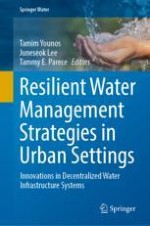This book documents innovative approaches for integrating green technologies and decentralized water infrastructure. The two major components of green decentralized water infrastructure are: (1) using locally available alternative water sources (rainwater, greywater, and brackish/saltwater) (at multiple scales, e.g., a single building to a neighborhood community level); and (2) using renewable energy resources (solar, wind, biomass, geothermal, other). Chapter 1, introduces the concept and framework of green decentralized water infrastructure. The subsequent nine chapters give a detailed description of global case studies, and discuss significant components of the green decentralized water infrastructure and the challenges. The chapters document global case studies and prospects (chapters 1-7) followed by challenges facing decentralized water infrastructure (chapters 8-10). The book will provide a cross-disciplinary knowledge-base for smart & futuristic water management in urban settings and a significant opportunity for sharing smart and decentralized water technologies at the global level
